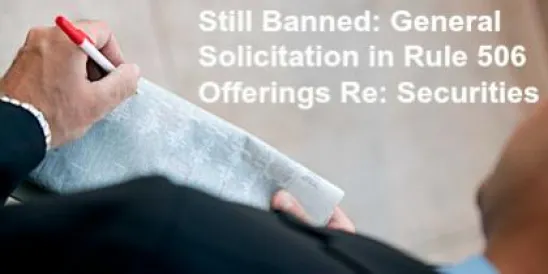Ten months have passed since the SEC proposed rules implementing the requirement of Title II of the JOBS Act that the prohibition against general solicitation and general advertising in Rule 506 be eliminated. Those proposed rules were issued nearly two months after the 90 day deadline in the JOBS Act for final rules dealing with this matter. Since the publication of these proposed rules, the SEC has gone through two Chairpersons, neither of whom moved the ball forward. Thus, despite the requirements of the JOBS Act, an issuer conducting an offering pursuant to Rule 506 still cannot generally solicit people to find out (a) whether they meet the requirements for accredited investors and (b) if so, whether they would be interested in making an investment in the issuer.
There were, as well, structural issues with the proposed rules. For legal practitioners, one of the best parts of Rule 506 is that it is a “safe harbor” – you meet the clear, objective requirements, you get the benefit of the exemption. The proposed rules, on the other hand, did not establish such clear, objective requirements for being able to rely on the newly created “506 plus” offering that would allow issuers to engage in a private placement that used general solicitation.
Other criticisms about the proposed rule have come from both sides of the aisle.
On the investor protection side, the SEC Investor Advisory Committee issued proposed additional investor protections to the proposed rules that were backed by various consumer groups. These recommendations included requiring that all solicitation material used by an issuer in the Rule 506 offering be furnished to the SEC and that additional disclosures be made by the issuer on a either new Form GS or an enhanced Form D. Furthermore, in an article in the New York Times, Steve Rattner (who counseled the Treasury in connection with auto industry bailout) suggested that there be some sort of standardized disclosure for private equity and hedge funds using general solicitation in connection with a Rule 506 offering.
On the issuer side, complaints were raised that the proposed rule imposed too many burdens on small businesses trying to raise capital. For example, in its supplementary comment letter to the SEC on the proposed rule, the National Small Business Association pointed to the legislative history of the JOBS Act on this subject (what little there was) and argued that all Congress was asking the SEC to do was to simply eliminate the ban on general solicitation for Rule 506 offerings, and nothing else.
So what are the tea leaves telling us about what the SEC is going to do about the requirement of the JOBS Act that the ban on general solicitation for Rule 506 offerings be eliminated?
Will the SEC do nothing? That’s a distinct possibility. There are several provisions of Dodd-Frank (passed years before the JOBS Act) that the SEC still has not acted on. For example, the so-called “bad boy” provisions (found in Rule 262 in Regulation A) were supposed to be added to the requirements for an issuer that is using Rule 506. This seemingly very simple requirement has not been made into a final rule by the SEC to this day – after it issued proposed rules over two years ago. Is the elimination of the ban on general solicitation to be ignored the same way?
Will the SEC adopt the proposed rule as is without amendment? Given the amount of commentary that was received by the SEC on the proposed rule, this would seem to be unthinkable. Yet, Bloomberg reported recently that Chairperson Mary Jo White “has suggested the commission pass the existing plan without major changes and add protections later.”
Given that they have received numerous comments on the proposed rule and have had almost a year to ruminate on them, will the SEC issue a final rule that addresses these comments and provide a workable safe harbor exemption? One can only hope.



 />i
/>i

